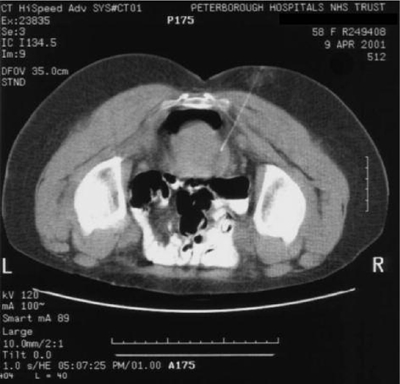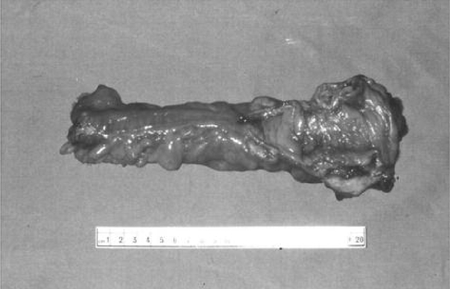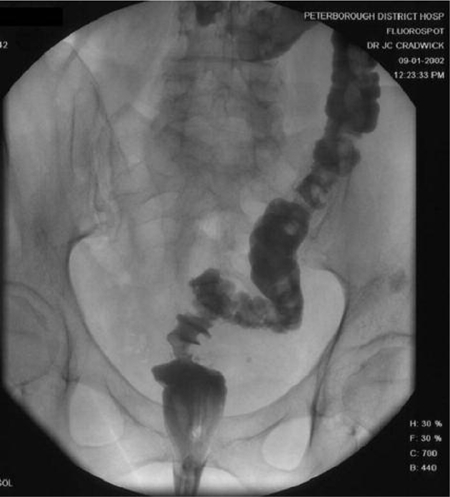Abstract
A case of malignant transformation in an extra-ovarian site, 13 years after total abdominal hysterectomy and bilateral salpingo-oophorectomy, is discussed in a patient on long-term oestrogen implants, which highlights the potential risks surrounding the use of long-term oestrogen replacement therapy.
Keywords: Endometriosis, Extra-ovarian, Adenocarcinoma, HRT, Oestrogen
Endometriosis is common, occurring in 4–17% of women of reproductive age. However, malignancy arising from endometriosis in extra-ovarian sites is extremely rare.1
Hormone replacement therapy (HRT) following surgical resection of endometriosis is often used in clinical practice as the potential benefits include symptom relief of surgical menopause (hypo-oestrogenism), the postponement of bone loss, and protection from cardiovascular disease. These benefits are traditionally seen to outweigh the possible risk from a recurrence of endometriosis. However, there appears to be a definite risk of recurrence of endometriosis and its transition to adenocarcinoma, with the use of postoperative HRT.2
A case of such a malignant transformation in an extra-ovarian site, 13 years after total abdominal hysterectomy and bilateral salpingo-oophorectomy, is discussed in a patient on long-term oestrogen implants, which highlights the potential risks surrounding the use of long-term oestrogen replacement therapy.
Case report
A 59-year-old woman was seen in out-patient clinic following a general practitioner referral for an 8-week history of constipation, tenesmus and 7 kg weight loss.
Her past medical history was significant for the diagnosis of endometriosis 21 years previously, which was treated for 9 months with Danazol. Her symptoms recurred 8 years later, and an endometriotic deposit was excised from the umbilicus. The following year, a total abdominal hysterectomy with bilateral salpingo-oophorectomy and implantation of oestradiol (50 mg) and testosterone (100 mg) was performed. During the procedure, it was noted that the patient had severe ovarian endometriosis and a considerable amount of endometriosis in the floor of the pelvis. Histology revealed no evidence of malignancy.
The patient remained well for 13 years following this procedure; on referral to out-patient clinic, examination by sigmoidoscopy revealed an extrarectal mass at 10 cm. A computed tomography scan was, therefore, requested (Fig. 1). The results of the scan revealed a 5-cm cystic mass within the pelvis thought to be arising from the bowel wall, but possibly due to an endometrioma. Nodularity within the cyst was concerning, and following unremarkable biopsies and fine needle aspiration, it was decided that surgery be performed for removal of the lesion. An anterior resection with covering loop ileostomy was performed.
Figure 1.

Computed tomography scan demonstrating a 5-cm cystic mass within the pelvis.
The excised bowel was sent for histological analysis, which reported the presence of a 4 × 4 cm nodular lesion attached to the anterior wall of the rectum, involving the muscularis propria and the perirectal fat. Within the lesion was a 1.5-cm, well-demarcated, cystic, endometrioid adenocarcinoma (Fig. 2), which had been completely excised. The presence of benign ‘Mullerian’ inclusions was also found in two lymph nodes. Her postoperative course was uneventful and, following an out-patient gastrograffin enema, closure of the ileostomy was performed (Fig. 3).
Figure 2.

Excised rectum, with the presence of a 4 × 4 cm nodular lesion attached to the anterior wall.
Figure 3.

Gastrograffin enema, following the removal of the endometrioid adenocarcinoma.
Discussion
The above case highlights the difficulty in treating this common condition. Endometriosis is benign, but malignant transformation of endometriosis is thought to occur in 1% of cases. The occurrence of intestinal endometrioid malignancy is, however, uncommon.1
The persistence or recurrence of endometriosis after a total abdominal hysterectomy and bilateral saplingo-oophorectomy is rare with one series reporting that no recurrence occurred without the use of HRT, as opposed to a 20% rate if oestrogen therapy was initiated.3
Advice regarding the use of oestrogen therapy for women with a history of endometriosis with a surgical menopause is confusing. The recommendations range from minimal low-dose oestrogen therapy, low-dose oestrogen after a postoperative delay of 3–6 months, progestogen only for at least 6 months before adding oestrogen to the immediate use of oestrogen without progestogen cover.4,5
This case supports the need for careful consideration of exogenous oestrogen therapy in patients with extensive endometriosis. It is suggest that such patients do not receive oestrogen replacement therapy during the first 3–6 months following total abdominal hysterectomy and bilateral salpingo-oophorectomy; in the event that exogenous oestrogen treatment is required, it be covered with progestogen, thereby preventing the persistence of endometriosis in patients with disease. Our patient received unopposed oestrogen for 13 years.
Furthermore, the use of exogenous oestrogens in patients with a previous history of extensive endometriosis should only be commenced with the provision of regular follow-up. In addition, suspicion of malignant transformation of endometriosis should be considered in patients presenting with symptoms of altered bowel habit, pelvic pain, dyspareunia, and a history of endometriosis and oestrogen replacement therapy.
References
- 1.Salvin RE, Krum R, Van Dinh T. Endometriosis-associated intestinal tumours: a clinical review and pathological study of 6 cases with a review of the literature. Hum Pathol. 2000;4:456–63. doi: 10.1053/hp.2000.6712. [DOI] [PubMed] [Google Scholar]
- 2.Taylor M, Bowen-Simpkins P, Barrington J. Complications of unopposed oestrogen following radical surgery for endometriosis. J Obstet Gynaecol. 1999;19:647–8. doi: 10.1080/01443619963950. [DOI] [PubMed] [Google Scholar]
- 3.Grey LA. Endometriosis of the bowel: role of bowel resection, superficial excision, and oophorectomy in treatment. Ann Surg. 1973;177:580–7. doi: 10.1097/00000658-197305000-00011. [DOI] [PMC free article] [PubMed] [Google Scholar]
- 4.Malinak LR. Proceedings of the ICI Conference on Endometriosis; September 1989; Cambridge. Camforth: Parthenon; 1990. p. 142. [Google Scholar]
- 5.Belchetz PE. Hormonal treatment of postmenopausal women. N Engl J Med. 1994;330:1062–71. doi: 10.1056/NEJM199404143301508. [DOI] [PubMed] [Google Scholar]


